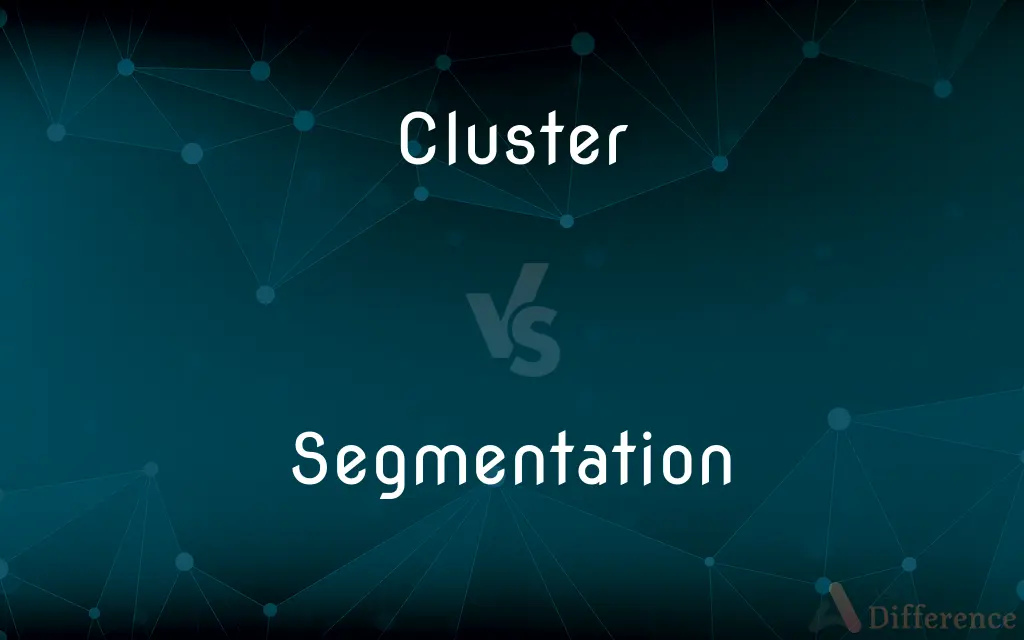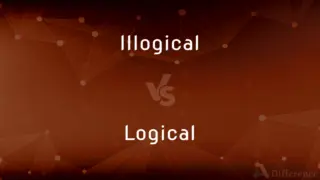Cluster vs. Segmentation — What's the Difference?
By Fiza Rafique & Urooj Arif — Updated on April 17, 2024
Cluster refers to a group of similar items or entities naturally formed, whereas segmentation involves intentionally dividing items or a population into segments based on specific criteria.

Difference Between Cluster and Segmentation
Table of Contents
ADVERTISEMENT
Key Differences
Clustering is a process used primarily in statistics and data analysis where a set of objects are grouped together based on their similarities, without prior knowledge of the group definitions. On the other hand, segmentation is often a deliberate activity, especially in marketing, where populations or data are divided into segments based on predefined criteria such as demographics, behavior, or other characteristics.
In clustering, the goal is to discover inherent structures in the data, often using algorithms that perform the task automatically. Whereas, segmentation usually serves specific strategic purposes, such as targeting different groups in a marketing campaign, and involves clear, often manually set boundaries based on the objectives.
While clustering is data-driven and its groups are defined by the data itself, segmentation is hypothesis-driven, guided by specific business questions or hypotheses that dictate how segments are formed and defined.
Clustering can be unsupervised, meaning it doesn't rely on predetermined labels or outcomes; the algorithm groups data based on internal patterns. Conversely, segmentation can be considered a supervised approach, where the criteria for segmentation are established based on desired outcomes or known attributes.
Clustering is used for exploratory data analysis, to identify relationships and patterns that are not readily apparent. Segmentation, however, is used to create actionable groups that can be directly targeted with specific interventions or messages.
ADVERTISEMENT
Comparison Chart
Purpose
To discover natural groupings in data based on similarities.
To divide data or populations into segments based on specific, predefined criteria.
Approach
Data-driven and unsupervised.
Hypothesis-driven and often supervised.
Usage
Exploratory data analysis, machine learning.
Marketing, strategic planning, resource allocation.
Definition of Groups
Defined by the algorithm based on data.
Defined by users based on strategic objectives.
Nature
Inherent and organic.
Deliberate and planned.
Compare with Definitions
Cluster
A collection of objects or entities that are similar to each other but distinct from other groups.
The algorithm identified a cluster of users with similar purchasing behaviors.
Segmentation
Involves predefined criteria such as age, income, lifestyle, etc.
The segmentation was based on income levels to identify potential premium product buyers.
Cluster
Used in various fields like statistics, machine learning, and data mining.
Clustering techniques are essential in the field of bioinformatics for grouping genetic information.
Segmentation
Often used in marketing to target specific demographics.
Age segmentation is commonly used in advertising to reach different age groups effectively.
Cluster
Methodologically, it involves grouping data points into subsets.
The research team used hierarchical clustering to organize the data.
Segmentation
Can be used for resource allocation and strategic planning.
The city's resource segmentation plan allocates more funds to needier neighborhoods.
Cluster
Focuses on finding patterns without prior labeling.
Cluster analysis helped uncover unknown patterns in the customer data.
Segmentation
Aids in developing focused strategies for each segment.
The marketing team developed unique strategies for each customer segment identified in the study.
Cluster
Can be visualized in scatter plots or dendrograms.
The scatter plot displayed several distinct clusters based on the dataset.
Segmentation
The process of dividing a broader market or population into subgroups.
Market segmentation allows companies to tailor their products to specific customer needs.
Cluster
A group of the same or similar elements gathered or occurring closely together; a bunch
"She held out her hand, a small tight cluster of fingers" (Anne Tyler).
Segmentation
Division into segments.
Cluster
(Linguistics) Two or more successive consonants in a word, as cl and st in the word cluster.
Segmentation
(Embryology) See cleavage.
Cluster
A group of academic courses in a related area.
Segmentation
The act or an instance of dividing into segments
Cluster
To gather or grow into bunches.
Segmentation
The state of being divided into segments
Cluster
To cause to grow or form into bunches.
Segmentation
The partitioning of an image into groups of pixels
Cluster
A group or bunch of several discrete items that are close to each other.
A cluster of islands
A cluster of flowers grew in the pot.
A leukemia cluster has developed in the town.
Segmentation
The act or process of dividing into segments; specifically (Biol.), a self-division into segments as a result of growth; cell cleavage; cell multiplication; endogenous cell formation.
Cluster
A number of individuals grouped together or collected in one place; a crowd; a mob.
Segmentation
(embryology) the repeated division of a fertilised ovum
Cluster
(astronomy) A group of galaxies or stars that appear near each other.
The Pleiades cluster contains seven bright stars.
Segmentation
The act of dividing or partitioning; separation by the creation of a boundary that divides or keeps apart
Cluster
A sequence of two or more words that occur in language with high frequency but are not idiomatic; a chunk, bundle, or lexical bundle.
Examples of clusters would include "in accordance with", "the results of" and "so far"
Cluster
(music) A secundal chord of three or more notes.
Cluster
(phonetics) A group of consonants.
The word "scrub" begins with a cluster of three consonants.
Cluster
(computing) A group of computers that work together.
Cluster
(computing) A logical data storage unit containing one or more physical sectors (see block).
Cluster
A subset of a population whose members are sufficiently similar to each other and distinct from others as to be considered a distinct group; such a grouping in a set of observed data that is statistically significant.
Cluster
(military) A set of bombs or mines released as part of the same blast.
Cluster
(army) A small metal design that indicates that a medal has been awarded to the same person before.
Cluster
A clusterfuck.
Cluster
(chemistry) An ensemble of bound atoms or molecules, intermediate in size between a molecule and a bulk solid.
Cluster
(intransitive) To form a cluster or group.
The children clustered around the puppy.
Cluster
(transitive) To collect into clusters.
Cluster
(transitive) To cover with clusters.
Cluster
A number of things of the same kind growing together; a bunch.
Her deeds were like great clusters of ripe grapes,Which load the bunches of the fruitful vine.
Cluster
A number of similar things collected together or lying contiguous; a group; as, a cluster of islands.
Cluster
A number of individuals grouped together or collected in one place; a crowd; a mob.
As bees . . . Pour forth their populous youth about the hiveIn clusters.
We loved him; but, like beastsAnd cowardly nobles, gave way unto your clusters,Who did hoot him out o' the city.
Cluster
To grow in clusters or assemble in groups; to gather or unite in a cluster or clusters.
His sunny hairCluster'd about his temples, like a god's.
The princes of the country clustering together.
Cluster
To collect into a cluster or clusters; to gather into a bunch or close body.
Not less the bee would range her cells, . . . The foxglove cluster dappled bells.
Or from the forest falls the clustered snow.
Cluster
A grouping of a number of similar things;
A bunch of trees
A cluster of admirers
Cluster
Come together as in a cluster or flock;
The poets constellate in this town every summer
Cluster
Gather or cause to gather into a cluster;
She bunched her fingers into a fist
The students bunched up at the registration desk
Common Curiosities
How does clustering help in data analysis?
Clustering helps identify patterns and relationships in data that are not immediately obvious, aiding in deeper data analysis.
What types of criteria are used for segmentation?
Criteria for segmentation can include demographics, psychographics, geographic differences, behavior, etc.
Is segmentation always manual?
Segmentation often involves manual setup, but automated systems can also apply predefined rules to segment data.
Why is segmentation important in resource allocation?
Segmentation allows for more precise and effective allocation of resources by targeting those segments that will benefit most or need resources the most.
What is the main difference between clustering and segmentation?
Clustering groups data based on inherent similarities with no prior labels, while segmentation intentionally divides data based on predefined criteria.
What is an example of a clustering algorithm?
K-means is a popular clustering algorithm used to partition a dataset into K distinct, non-overlapping clusters.
What makes a good cluster in data analysis?
A good cluster in data analysis has high internal homogeneity (similarity within the cluster) and high external heterogeneity (dissimilarity with other clusters).
What are the challenges in effective segmentation?
Effective segmentation can be challenging due to inaccuracies in data, evolving market conditions, or poorly defined segmentation criteria.
Can clustering be used in marketing?
Yes, clustering can be used in marketing to discover natural segments within customer data that might not have been previously considered.
How does clustering differ from classification?
Clustering is unsupervised and discovers groupings in data, while classification is supervised and categorizes data based on known labels.
How do businesses benefit from segmentation?
Businesses benefit by being able to tailor their products, services, and marketing efforts to meet the specific needs of different segments, improving efficiency and effectiveness.
Can segmentation be done on any type of data?
Segmentation can be applied to any data where distinct groups are beneficial, such as customer data, sales data, or population demographics.
How does segmentation impact customer experience?
By understanding different customer segments, companies can customize their interactions and enhance the overall customer experience, making it more personal and relevant.
What tools are used for performing segmentation?
Tools for segmentation range from simple statistical tools to complex CRM software that can manage and analyze customer segments.
What is a practical example of clustering in everyday business?
Retailers use clustering to group customers by purchase behavior for targeted promotions.
Share Your Discovery

Previous Comparison
Followup vs. Follow
Next Comparison
Illogical vs. LogicalAuthor Spotlight
Written by
Fiza RafiqueFiza Rafique is a skilled content writer at AskDifference.com, where she meticulously refines and enhances written pieces. Drawing from her vast editorial expertise, Fiza ensures clarity, accuracy, and precision in every article. Passionate about language, she continually seeks to elevate the quality of content for readers worldwide.
Co-written by
Urooj ArifUrooj is a skilled content writer at Ask Difference, known for her exceptional ability to simplify complex topics into engaging and informative content. With a passion for research and a flair for clear, concise writing, she consistently delivers articles that resonate with our diverse audience.















































